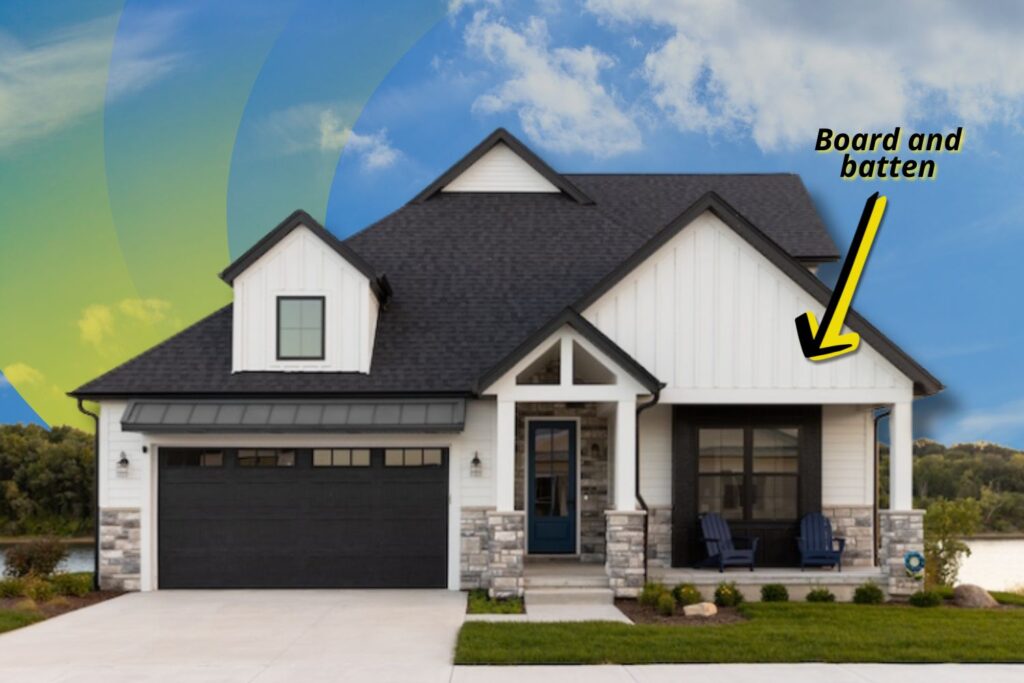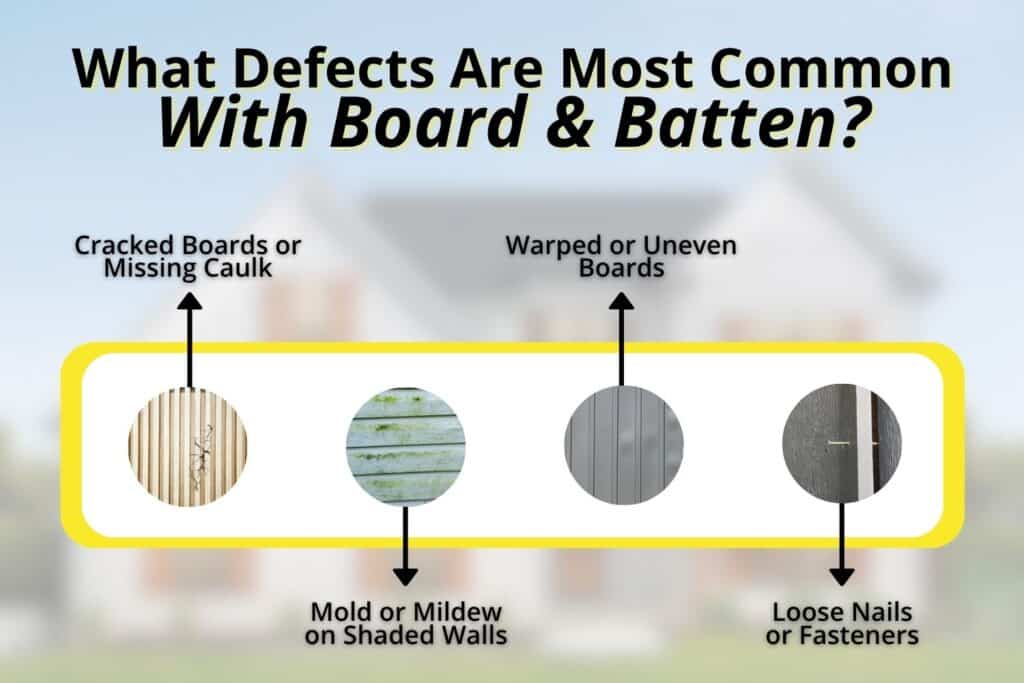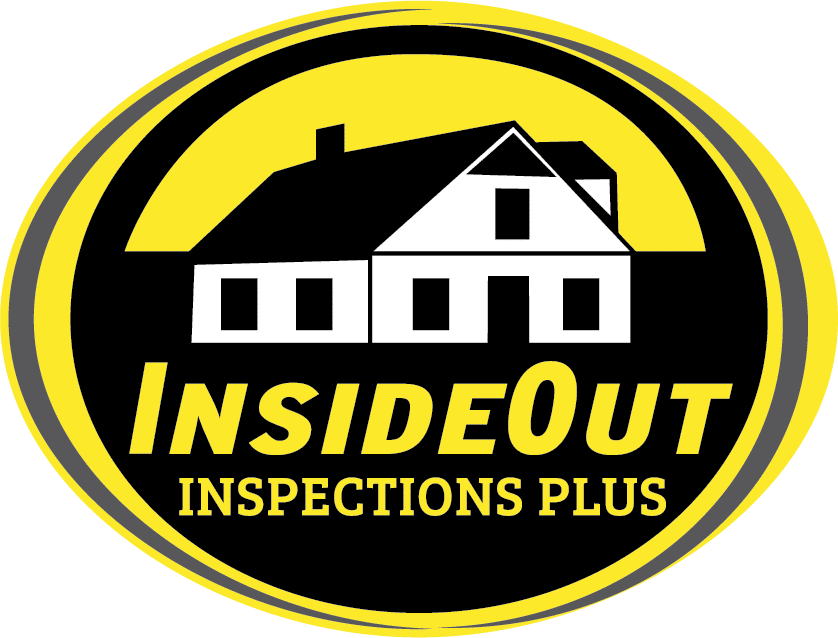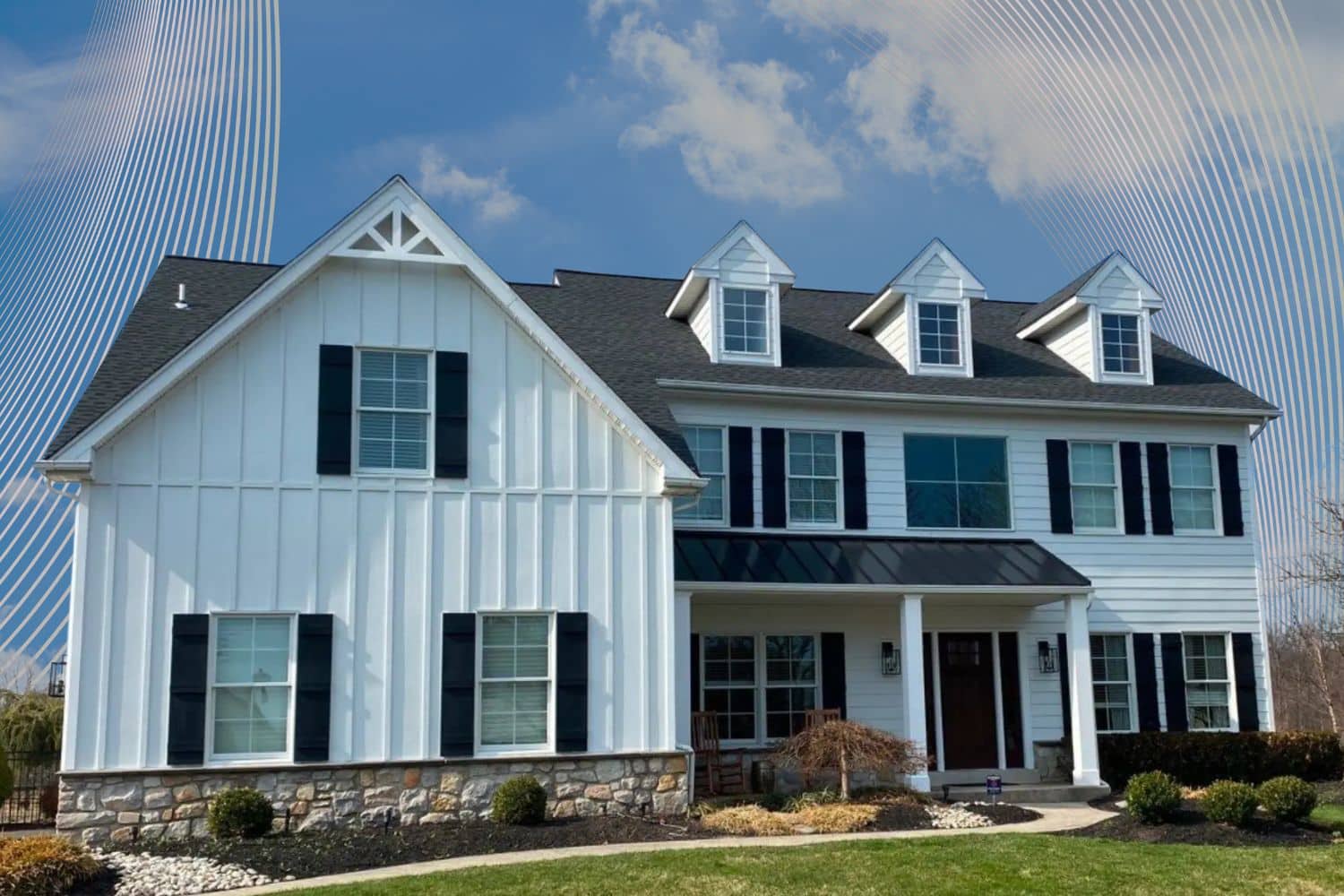Board and batten siding is a popular exterior material that can give homes a fresh, timeless look. The clean vertical lines add height and visual balance, working well on both modern builds and older farm-style homes across Michigan and Ohio.
But like any exterior material, board and batten siding performs best when properly installed and maintained. At InsideOut Inspections Plus, our team has seen both the benefits and the problem areas that can appear over time. In this guide, we’ll outline the major pros and cons, typical costs, maintenance tips, and more.
What Is Board and Batten Siding?
Board and batten siding features wide vertical boards fastened side by side, with narrow strips called battens covering the seams. This design creates dimension while sealing gaps that could let water in.
Originally used on barns and early farmhouses, board and batten has evolved into a stylish option for residential properties.
Today, it’s available in materials such as natural wood, engineered wood, vinyl, and fiber cement, each offering a different balance of cost, appearance, and durability.
| Material | Lifespan | Maintenance | Key Advantages | Common Concerns |
| Wood | 25–40 years | High | Natural appearance, easy to paint or stain | Rot, insects, frequent repainting |
| Engineered Wood | 30–50 years | Moderate | Good durability, less prone to warping | Needs sealing and moisture protection |
| Fiber Cement | 40–60 years | Low | Fire-resistant, weather-tough, pest-proof | Higher cost, requires pro installation |
| Vinyl | 20–30 years | Low | Affordable, minimal upkeep | Can warp or crack in temperature changes |
According to one industry report, replacing siding with fiber cement delivers an average 88% return on investment nationally.
That means homeowners often recoup most of their costs through resale value and improved curb appeal.

Advantages of Board and Batten Exterior Siding
1) Strong Curb Appeal
Few siding styles offer the same visual impact. The vertical layout adds a sense of height and elegance, making homes look taller and more refined.
Many homeowners choose board and batten as an accent on gables or entryways to boost overall appearance.
2) Solid Weather Resistance
When installed correctly, this siding performs well against rain, snow, and wind. According to building research published in MDPI, over 60% of residential water leaks start where siding meets windows, doors, or other openings, often due to failed flashing or seals.
In the Midwest, where freeze-thaw cycles are common, engineered wood and fiber cement handle expansion and contraction better than raw wood.
3) Energy and Moisture Efficiency
Board and batten can slightly improve insulation when combined with house wrap or foam sheathing.
Home sealing and insulation improvements can save homeowners an average of 15% on heating and cooling costs. Because battens overlap seams, they also guide water downward, helping prevent leaks and wood rot when maintained properly.
4) Simple Repairs and Longevity
If a single board or batten becomes damaged, you can replace it individually rather than removing large wall sections. This makes long-term care more affordable and less disruptive than with continuous panel systems.
5) Flexible Design Options
Board and batten complements nearly every architectural style. Whether paired with stone, brick, or horizontal lap siding, it adapts easily. It can be stained for a rustic look or painted in any color for modern contrast.
The ability to customize both color and spacing is a key reason for its growing popularity in Michigan and Ohio neighborhoods.
Disadvantages of Board and Batten Siding
1) Precision Installation Required
Board and batten siding demands accuracy. If the boards aren’t aligned or the flashing isn’t installed correctly, water can penetrate behind the panels.
During inspections, we often find issues such as unsealed joints, cracked caulk, or missing weather barriers (all of which shorten siding lifespan).
2) Maintenance for Wood Options
Wood siding looks beautiful but requires ongoing care. It must be sealed or repainted every few years to prevent rot, mildew, and insect damage.
Engineered wood and fiber cement require less upkeep but still need periodic inspection to catch small cracks or peeling paint before moisture sneaks in.
3) Higher Upfront Cost
Board and batten siding costs more to install than standard vinyl or aluminum because it uses more material and takes extra time to align.
However, it tends to last longer and adds more resale value, making it a smarter investment over time.
4) Susceptible to Temperature Changes
Michigan and Ohio experience wide temperature swings. Poorly installed boards can warp, buckle, or pull away when materials expand and contract seasonally.
Proper spacing and fasteners are essential for long-term durability and safety.
Risk of Hidden Moisture
If water manages to get behind battens or under seams, it can sit against the wall sheathing. Over time, that trapped moisture may cause structural damage.
Regular inspections help catch these problems before they spread.
Cost Breakdown
| Material Type | Average Cost per Sq. Ft. (Installed) | Estimated Total for 2,000 Sq. Ft. Home | Maintenance Level | Expected Lifespan |
| Vinyl (Board & Batten Style) | $3 – $6 | $6,000 – $12,000 | Low | 20 – 30 years |
| Engineered Wood | $5 – $11 | $10,000 – $22,000 | Moderate | 30 – 50 years |
| Natural Wood | $7 – $14 | $14,000 – $28,000 | High | 25 – 40 years |
| Fiber Cement | $6 – $15 | $12,000 – $30,000 | Low | 40 – 60+ years |
| Board & Batten (Overall Average) | $5 – $13 | $10,000 – $26,000 | Varies by material | Up to 60+ years |
For a 2,000-square-foot home, full installation typically ranges from $10,000 to $26,000, depending on materials and complexity.
Regional Insights for Michigan and Ohio
- Michigan homeowners typically spend $28,000 to $57,000 for premium siding on a 1,500-square-foot home.
(Peak Home Exteriors, 2025) - In Ohio, standard vinyl runs around $3 to $4.10 per square foot, while higher-end siding such as engineered wood or fiber cement averages $5 to $12 per square foot.
(Roof Revivers and Price Brothers Restoration, 2025)
While the price is higher than basic vinyl, board and batten siding offers better durability and visual impact. For many homeowners, the improved energy efficiency and long lifespan justify the added cost.
Maintenance and Inspection Tips
Consistent care prevents costly repairs and helps your siding reach its full lifespan.
Quick Checklist
- Wash once a year using mild soap and water.
- Check for cracks, loose battens, or peeling paint every spring and fall.
- Repaint or reseal wood every five to seven years.
- Trim trees and shrubs to maintain airflow and prevent scratches.
- Inspect after major storms for any warping or shifting.
Routine exterior maintenance can extend a siding’s life expectancy, which adds years of use for a properly cared-for home.

Common Issues Found During Inspections
The team at InsideOut Inspections Plus frequently identifies several recurring issues in homes with board and batten siding:
- Cracked or missing caulk at joints and corners
- Mold or mildew on shaded or north-facing walls
- Warping near eaves or window frames
- Nails backing out from thermal movement
- Water stains or soft areas near the trim
Most of these issues start small and go unnoticed until they cause visible damage. Regular inspections help you spot them early, before they compromise your home’s structure.
Related Questions Homeowners Ask
Does board and batten siding increase home value?
Yes. Homes with clean, well-maintained exteriors tend to sell faster and closer to the asking price. The design’s curb appeal makes it especially attractive to buyers looking for a blend of character and modern style.
How can I tell if my siding is hiding water damage?
Look for peeling paint, warped boards, or musty smells. These can signal trapped moisture behind panels. A professional inspection can confirm hidden damage before it spreads.
What other parts of my exterior should be inspected with the siding?
Your siding works with other systems that protect your home. Inspect the roof, gutters, windows, trim, and foundation at the same time to catch early signs of leaks or wear.
When to Call a Professional
Even durable siding can develop hidden damage. If you notice soft or spongy boards, peeling paint, bubbling, or higher energy bills, schedule a professional inspection before the issue worsens.
At InsideOut, we perform thorough exterior evaluations across Michigan and Ohio.
Our inspectors use moisture meters and thermal imaging tools to identify problems that are invisible to the eye, such as leaks behind siding or insulation gaps.
You should consider an inspection if:
- Your home is more than ten years old and hasn’t had a recent exterior evaluation
- You’re preparing to sell or buy a home with board and batten siding
- You suspect poor installation or notice uneven boards
- You see mold, warping, or water damage marks that keep reappearing
A professional inspection helps you make informed maintenance decisions, prevent costly damage, and ensure your siding continues to protect your home efficiently.
Conclusion
Board and batten exterior siding combines beauty, versatility, and strength. When installed properly and maintained regularly, it can serve your home for decades while boosting its visual appeal and energy efficiency.
For a detailed look at how your siding is performing, schedule an inspection with InsideOut Inspections Plus.


